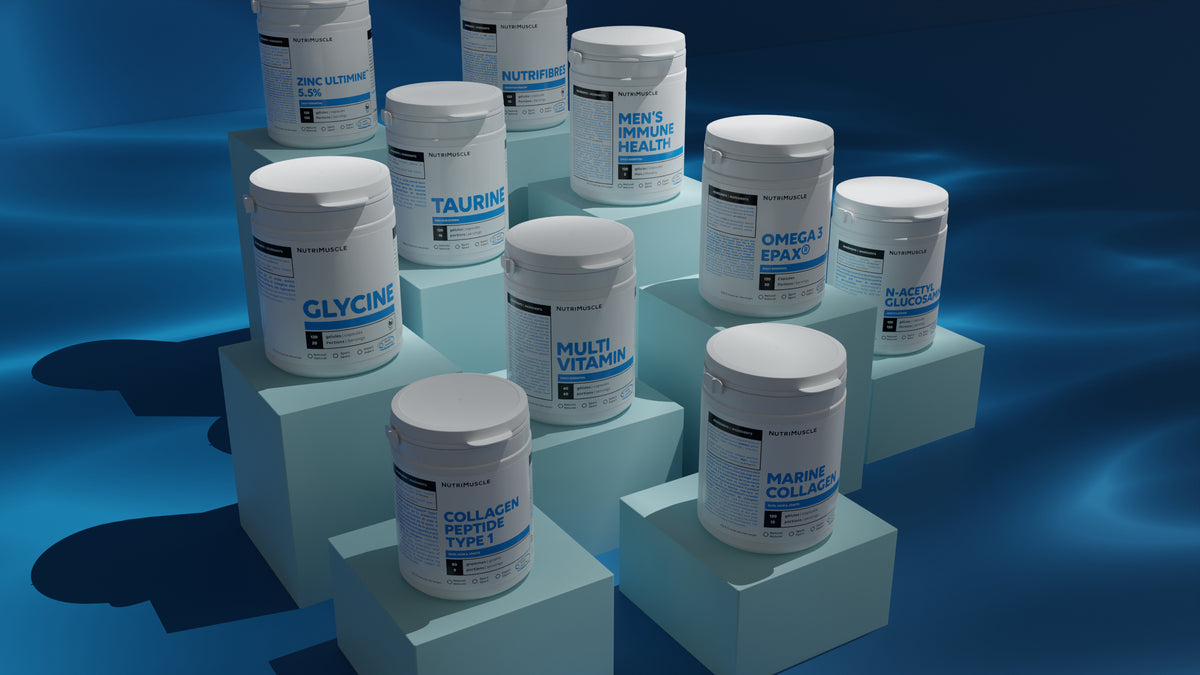N-acetylglucosamine
Glucosamine is a pioneer of gags, the second component of cartilages, tendons and ligaments, after collagen.
Retour sur la boutique
your cart is empty
Best-sellers
Isolat de whey native Créatine (Creapure®) Collagène Peptides Peptan® 1 Whey Native Oméga 3 Epax® Multivitamines BCAA 4.1.1 Constructeurs Multiminéraux ZMB PidolatesNouveautés
Pré-workout Lean gainer whey crème de riz Lean gainer Egg crème de riz Whey Hydrolysée Native Glutathion Setria® Curcumine Kératine (Cynatine - FLX®) Acides Aminés du Collagène 4.4.1 Enzymes digestives (Digezyme®) OptiMSM® (MéthylSulfonylMéthane)Isolat de whey native
Créatine (Creapure®)
Collagène Peptides Peptan® 1
Whey Native
Oméga 3 Epax®
Multivitamines
BCAA 4.1.1 Constructeurs
Multiminéraux
ZMB Pidolates
Pré-workout
Lean gainer whey crème de riz
Lean gainer Egg crème de riz
Whey Hydrolysée Native
Glutathion Setria®
Curcumine
Kératine (Cynatine - FLX®)
Acides Aminés du Collagène 4.4.1
Enzymes digestives (Digezyme®)
OptiMSM® (MéthylSulfonylMéthane)
Weight gain
Weight Loss & Cut
Stress reduction
Improved sexual performance
Joint well-being
Sleep optimization
Intellectual abilities
Recovery
Well-being of the heart
Le comparateur de protéines
Tout savoir sur la vitamine D
La Whey Hydrolysée Native : Nutrimuscle innove encore
Pourquoi la Whey Nutrimuscle mousse naturellement ?
Oméga 3
Collagen
Ashwagandha Shoden®
Super Collagen Mix en poudre
Collagène marin
Multivitamines
Multiminéraux
ZMB Pidolates
Vitamins
Collagens
Minerals
Plants
Fat Burners
Organic range
Joints
Brain
Heart
Digestion
Immune defenses
Sexuality
Weightloss
Nerve recovery
Sleep
Stress
Le comparateur de collagènes
How to choose your omega 3?
The guide to essential vitamins
All about vitamin C
Payment in 3 installments without fees
Splitting the cost of your basket into 3 payments, nothing could be simpler with Alma! Available from 100 euros.
Free delivery*
*Free delivery to a relay point from 30€ of purchase.
Extended delivery time
Due to a large order volume, please allow an additional 1 to 2 days on the standard delivery time. THANKS !
Get 19 points on this product with the loyalty program. How to take advantage of it?

















Focus on the product
Focus on the product
Good to know
La glucosamine est un composant essentiel utilisé par le corps pour synthétiser le cartilage, le tissu qui recouvre les extrémités des os dans les articulations.
What the product does

What the product does
Acceleration of the joint recovery process
N-acetylglucosamine accelerates the anabolism of cartilages so joint recovery. Research shows that the N-acetylglucosamine increases the speed of cartilage regeneration by 40 %.
No known immediate synergy.
No negative interaction known with other supplements.
In test tube, glucosamine is above all capable of inhibiting the degradation of existing joint cartilages and acts as a natural anti-inflammatory. It promotes lubrication and articular "nutrition" by stimulating the production of hyaluronic acid. There are several forms of glucosamine: glucosamine sulfate, glucosamine chlorhydrate, N-acetylglucosamine. What is the best?
N-acetylglucosamine Nutrimuscle is addressed:
to athletes who wish to prevent injuries, especially for force sports practitioners such as athletic force or bodybuilding, because heavy loads and repetitions Movements damage their joints. High impact sports athletes such as mountain biking or running also request their joints and have a profit to supplement to n-acetylglucosamine nutrimuscle;
to sedentary people who suffer from joint pain and wish to improve the comfort of their joints.
